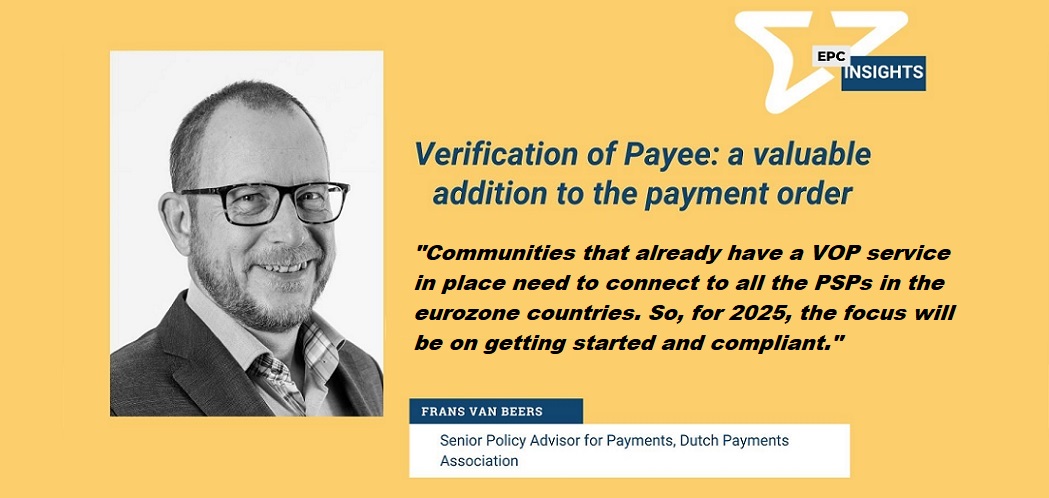
The Verifiction of Payee (VOP) scheme will be the standard underlayer for exchanging messages between Payment Service Providers (PSPs) to verify the Name-IBAN combination a payment service user (PSU) wants to use for making a payment. Being another brick in the wall against fraud, the VOP service will increase the PSUs’ confidence.
Verification of Payee (VOP) is one of the European Payments Council’s (EPC) newest schemes. It establishes a set of rules, practices, and standards for inter-payment service providers (PSPs) within the Single Euro Payments Area (SEPA). To learn more about the VOP scheme, EPC spoke with Frans van Beers, Senior Policy Advisor at the Dutch Payments Association (DPA). With extensive experience in European payment systems and a key role in developing the VOP scheme, Frans explains what VOP is, why it is important, and what we can expect in the future.
Could you briefly explain the VOP scheme for those who are unfamiliar with it?
The VOP scheme will be the standard underlayer – if you like – for exchanging messages between PSPs to verify the Name-IBAN combination a payment service user (PSU) wants to use for making a payment. For that, the PSP of the PSU must send a VOP request to the PSP of the beneficiary. The PSP of the beneficiary must reply to that request, with either match, no-match or close match. Based on that reply, the PSU can decide whether or not to authorise the payment.
If there is a match, the payer has confirmation that the payment will reach the intended beneficiary. A no-match or close match mean the payer will be warned that going ahead with the payment could lead to an unintended beneficiary receiving the money. In the event of a close match, the payer will be informed of the name registered for that IBAN in the system of the beneficiary’s PSPs and can then decide whether to authorise the payment or not. The VOP scheme will provide the specifications and services for the required interoperability between the PSPs.
Why is it important for PSPs to adhere to the VOP scheme?
The VOP service will increase the PSUs’ confidence. That’s why the European Commission made offering a VOP service a requirement in the Instant Payments Regulation (IPR) and with that came an obligation for PSPs. The EPC took the initiative to figure this obligation out in a new scheme rulebook.
According to the VOP rulebook, all parties involved will have specifications for the datasets, data exchange, processes, and obligations to provide standardised, interoperable VOP services in SEPA. As the VOP service is obligatory for all PSPs offering payment services in SEPA (EEA), the EPC Board decided that all PSP participants in SEPA Credit Transfer (SCT) and/or SEPA Instant Credit Transfer (SCT Inst) scheme must also adhere to the VOP scheme. An opt-out is foreseen for PSPs not bound by the IPR.
How does the VOP scheme enhance the security of payment systems?
The VOP service will support the PSU in making a payment order to the intended beneficiary. That will increase the level of confidence for that specific payment and the payment system in general.
VOP will also make it more difficult to lead consumers and businesses into making payments to fraudulent accounts. VOP is therefore another brick in the wall against fraud.
You also had an important role in the definition of the EPC Directory Service (EDS). Could you explain the relationship between VOP and the EDS?
The main objective of the VOP scheme rulebook is to support interoperability. As there is no infrastructure yet in place to exchange VOP messages between all PSPs in SEPA we had to find a solution. First and foremost, the challenge was deciding how all SEPA scheme participants could reach each other in an effective and efficient way to exchange VOP messages. The connectivity between VOP participants will be through application programming interfaces (APIs), which may be reached through communication with an endpoint (the Uniform Resource Identifier or URI).
We decided that setting up an EPC Directory Service (EDS) would be the best way forward. The EDS maintains this registry of the endpoints by which each participating PSP can be reached for VOP transactions. VOP scheme participants or their VOP service providers (Routing and Verification Mechanisms or RVMs), can copy (download) this registry to direct VOP requests to the PSP of the intended beneficiary. The EDS can by design also be used for the SEPA Payment Account Access (SPAA) and SEPA Request-to-Pay (SRTP) schemes. The EDS is the responsibility of the EPC and under its control. An external service provider performs the daily operations.
What are the future goals or developments planned for the VOP scheme?
Let’s start with getting the basic VOP scheme fully operational by October 2025 (the deadline for the IPR obligation) – i.e. supporting interoperability between all PSPs, which will be obliged to offer the VOP service by then. This will be a major challenge for all involved; each PSP has to setup its own VOP service or select a VOP service provider (RVM).
Communities that already have a VOP service in place need to connect to all the PSPs in the eurozone countries. So, for 2025, the focus will be on getting started and compliant. Having said that, we know that current VOP providers (RVMs) already have additional services in place. These will remain to support specific market needs. In 2026 we will discuss which additional requirements should be taken up in the next version of the EPC VOP scheme rulebook, most likely in the change management cycle for the 2027 release.
Banking 4.0 – „how was the experience for you”
„To be honest I think that Sinaia, your conference, is much better then Davos.”
Many more interesting quotes in the video below: